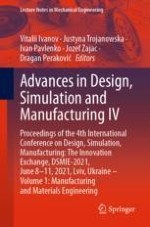2021 | Buch
Advances in Design, Simulation and Manufacturing IV
Proceedings of the 4th International Conference on Design, Simulation, Manufacturing: The Innovation Exchange, DSMIE-2021, June 8–11, 2021, Lviv, Ukraine – Volume 1: Manufacturing and Materials Engineering
herausgegeben von: Vitalii Ivanov, Justyna Trojanowska, Ivan Pavlenko, Jozef Zajac, Dragan Peraković
Verlag: Springer International Publishing
Buchreihe : Lecture Notes in Mechanical Engineering
